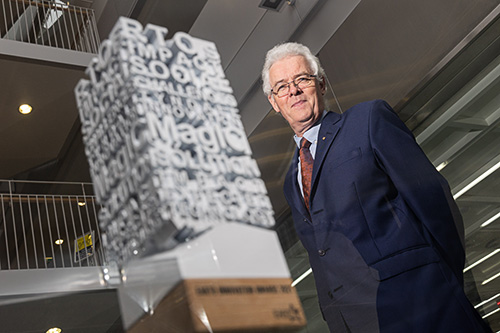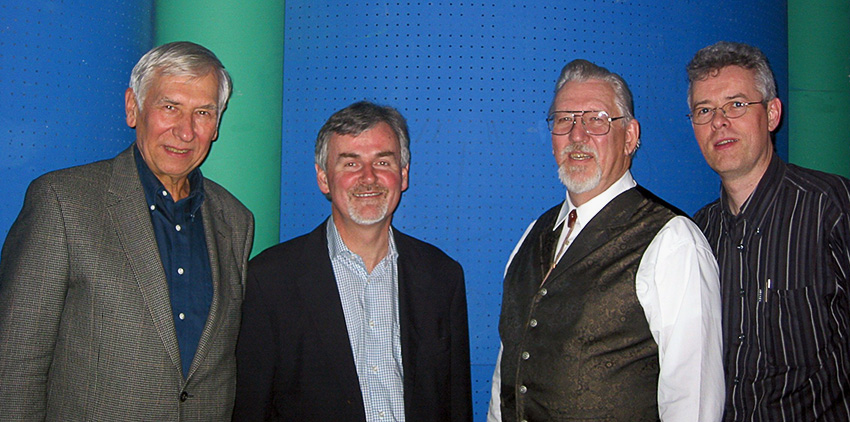 Professor Cian Ó Mathúna with the 2021 EARTO Innovation Professor Cian Ó Mathúna with the 2021 EARTO InnovationAward for Impact Expected |
![]() ne of PSMA's long-time contributors and supporters, Professor Cian Ó Mathúna, from Tyndall National Institute in Cork, Ireland has been recently named the recipient of two major international awards celebrating innovative technology created in Ireland, which could have a lasting environmental impact.
ne of PSMA's long-time contributors and supporters, Professor Cian Ó Mathúna, from Tyndall National Institute in Cork, Ireland has been recently named the recipient of two major international awards celebrating innovative technology created in Ireland, which could have a lasting environmental impact.
Minimizing energy consumption in electronics continues to be a major, technological challenge. Responding to this challenge, Cian, who is currently Head of MicroNano Systems at Tyndall, has, over the last 27 years, developed MagIC (Magnetics on Silicon), an innovative technology that can greatly extend the battery life of portable electronics and dramatically reduce the energy use of high-performance electronic systems and equipment.
The ground-breaking impact of the technology has been recently recognized with prestigious awards from the 400,000 member IEEE (Institute of Electrical and Electronics Engineers) and EARTO (European Association of Research and Technology Organisations).
The IEEE Power Electronics Society Technical Achievement Award for Integration and Miniaturisation of Switching Power Converters celebrates Cian's extraordinary, global influence and leadership over the last decade in bringing together the electronics industry and academia to collaborate toward the development of the Power Supply-on-Chip (PwrSoC).
Tyndall is the first Irish recipient of an EARTO Award, which recognizes key contributions from European research to high-impact, technological innovation. The 2021 EARTO Innovation Award for Impact Expected looks to the future and recognizes the impact Professor Ó Mathúna's research will have on the technology of the future. Including dramatically reducing system energy consumption, extending battery life and reducing the overall size, weight and cost of future electronic systems.
Tyndall's MagIC technology makes bulky magnetics components in electronic equipment to disappear onto the silicon chip, just like Gordon Moore and colleagues did with the transistor over 50 years ago. Using MagIC technology, electronics will be able to use power more efficiently by minimizing the energy wasted or lost as the battery powers the multiple-voltage rails required in multi-core microprocessor chips and/or other complex SoC chips. This improved efficiency can extend the charge time of batteries by more than 50%. The breakthrough technology will have a huge impact on markets for mobile phones, IT equipment, and any device needing a battery. It is also envisaged that the technology will deliver significant energy savings in servers in the data centre and high-performance computing space.
Professor Ó Mathúna said, "This ground-breaking and disruptive innovation is set to change the global approach to how power is managed in electronic devices and will contribute to addressing a critical environmental issue for society and our planet. We continue to partner extensively with global companies to develop and commercialize the technology which has already received more than €20M in funding from research, licensing and productization. We have joint publications with companies such as Global Foundries in Dresden and Singapore; Intel, USA; Philips in the Netherlands, TI in the USA; Wurth Electronics in Germany as well as a joint patent with Apple Computers."
Cian joined the November 2021 PSMA Board of Directors meeting and was very gracious and effusive in acknowledging the influence PSMA has had on the emergence of PwrSoC over the last 3 decades. Cian mentioned that he was first introduced to PSMA by Don Staffiere who managed to convince one of his Irish clients, Gary Duffy, then MD of Computer Products (later Artseyn Technologies) to fund Cian's attendance at the 1994 APEC. Cian came to APEC with a very limited background in power electronics but, through Don's introductions to PSMA, he began participating in the PSMA Technology Roadmap initiative, and was quickly able to leverage his expertise in microelectronics packaging which was just beginning to have a very positive impact on the miniaturization and integration of power electronics products.
 Joe Horzepa, Gary Duffy, Arnold Alderman and Cian Ó Mathúna at APEC in the mid 2000s Joe Horzepa, Gary Duffy, Arnold Alderman and Cian Ó Mathúna at APEC in the mid 2000s |
With the support of Don Staffiere, Bob Huljak, the late Prof. William Sarjeant and the strategic guidance and wisdom of Joe Horzepa (and Judy!), Cian engaged with Arnold Alderman and Doug Hopkins to run the Packaging Technical Committee with Brian Narveson and Ernie Parker later contributing their expertise. Around 1997/98, PSMA awarded NMRC (National Microelectronics Research Centre – the precursor to Tyndall) funding to undertake a special project on the state-of-the-art in commercial 3D power electronics packaging and followed this, in 2006/2007, with funding, for Tyndall and Anagenesis, on the very first study on fully-integrated power – the visionary and seminal "PSiP2PwrSoC" project.
Looking back, Cian sees this project as the inspiration for him to establish PwrSoC, the International Workshop on Power Supply on Chip which was first held in Cork in 2008 with over 100 international participants. At PwrSoC2010, Tyndall agreed to hand over the workshop to PSMA and the IEEE Power Electronics Society from which point the Workshop has become recognized as the flagship technical forum worldwide for both industry and academia to get together to discuss both the technological and business challenges and opportunities for PwrSoC.
In his closing remarks, Cian commented "the vision and strategic perspective of PSMA, over the last 27 years, has had a dramatic impact on seeding research in power electronics, on providing a dedicated forum to gain insight into major power industry challenges and, in particular, in providing me, and the wider team at NMRC/Tyndall, with the international perspective to succeed. For all of this, I am forever in PSMA's debt."
